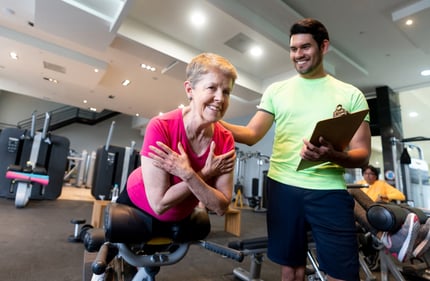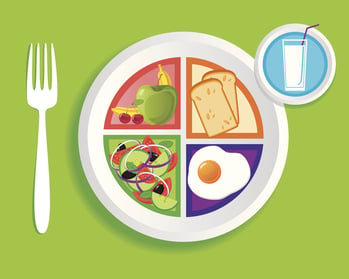 While the size and shape of fitness spaces can vary dramatically from one senior living community to the next, it is very common for there to be at least some dedicated space with exercise equipment for resident use. It’s also quite common for communities to offer group exercise classes as part of the activity program. In some cases, communities also offer a personal training service.
While the size and shape of fitness spaces can vary dramatically from one senior living community to the next, it is very common for there to be at least some dedicated space with exercise equipment for resident use. It’s also quite common for communities to offer group exercise classes as part of the activity program. In some cases, communities also offer a personal training service.
However, that’s often where the fitness-related services for seniors stop. Below are three additional considerations that will elevate your exercise program to better serve current residents and to attract prospects who are looking for their next home.
Membership
Establishing a membership practice for your fitness center will serve a few key purposes.
- The first is to help manage your liability tied to the community’s fitness spaces as well as to protect the seniors you serve. Fitness facility standards outlined by the American College of Sports Medicine are designed to be an industry-standard set of practices for the safe and effective management of fitness areas. Adhering to as many of their standards as is reasonable will help ensure the fitness program is successful for both your community and the residents.
- The second is to establish a database of active participants so that staff can accurately track who is using the fitness programs and services and how often. Tracking attendance by member allows your staff to proactively reach out to residents who have historically been regular participants and who may have slowed or stopped their activity, or to those residents who have not yet joined the fitness program.
Exercise Prescriptions
Many of today’s residents haven’t engaged in regular exercise outside of their lives in your community, so it’s intimidating for them to approach a treadmill, recumbent bike, or strength equipment. Providing residents with an expert who can create an exercise program based on individual goals and limitations is a great way to help a novice exerciser start to understand how to use the equipment. Following up the exercise prescription service with regular support during each workout demonstrates a real commitment to physical wellness in your community.
Senior Fitness Testing
Getting a baseline on your residents’ fitness level is a great way to help them understand the progress they can make in the fitness center to either maintain or improve their physical well-being. The senior fitness test provides those results and feeds well into the exercise prescription service outlined above. There is inexpensive software (and a manual) that can be used to administer the testing and provide the participant with results. The equipment for each test is also relatively inexpensive and includes items like cones, a step bench, and a timer, among other equipment.
In addition to residents benefitting from their individual results, the community can use aggregate fitness testing data to determine strengths and weaknesses within the fitness program so that classes and other programs appropriately target residents’ fitness needs.
What’s Next?
To be fair, the membership piece could be managed by a lifestyle director. But the exercise prescription and fitness assessment pieces need to be managed by a trained exercise professional who understands the ins and outs of prescribing exercise for older adults. Read about how to hire a qualified fitness professional for your community, or consider working with us because NIFS managers provide these key services as part of our standard senior living fitness programming. Or, click the button below if you’re looking for more ideas about what you should expect from a robust fitness program.


 Grocery shopping takes time, preparation, patience, and organization. But throw kids in the buggy (or cart) with you, and usually you end up with a big old, stressful mess. Take it from a mom with three kids under the age of 5; I know firsthand that it can be done happily and without tantrums (well, for the most part). But it’s taken some practice.
Grocery shopping takes time, preparation, patience, and organization. But throw kids in the buggy (or cart) with you, and usually you end up with a big old, stressful mess. Take it from a mom with three kids under the age of 5; I know firsthand that it can be done happily and without tantrums (well, for the most part). But it’s taken some practice. 
 According to the
According to the 
 The holidays are right around the corner, and the first thing that comes to mind is all that food! You don’t want to look like a Santa at the start of the New Year! Well, don’t feel guilty about consuming the goodies; just get smart! If you have an understanding of what it takes to properly fuel your body, specifically as you age, the healthy eating process doesn’t seem so daunting. Older adults have different needs, and there are some key nutrients that are really important to maintain.
The holidays are right around the corner, and the first thing that comes to mind is all that food! You don’t want to look like a Santa at the start of the New Year! Well, don’t feel guilty about consuming the goodies; just get smart! If you have an understanding of what it takes to properly fuel your body, specifically as you age, the healthy eating process doesn’t seem so daunting. Older adults have different needs, and there are some key nutrients that are really important to maintain. 
 We see it, we eat it. Usually that’s how it goes, right? Of course we eat too much, but is it really our faults? Well, unfortunately for Americans, the portion distortion mania has gotten out of hand—and so has obesity. Over time, we’ve gotten so used to the larger portions being served at restaurants, we’ve come to think this is normal. Then of course that thinking spills over into a food addiction at home, too. More food, more food, more food. The craziness needs to stop now! (Here are
We see it, we eat it. Usually that’s how it goes, right? Of course we eat too much, but is it really our faults? Well, unfortunately for Americans, the portion distortion mania has gotten out of hand—and so has obesity. Over time, we’ve gotten so used to the larger portions being served at restaurants, we’ve come to think this is normal. Then of course that thinking spills over into a food addiction at home, too. More food, more food, more food. The craziness needs to stop now! (Here are 
 As the Wellness Coordinator at NIFS, I get to meet a lot of great clients and help them attain their nutritional goals. I have noticed some common weight-loss questions that arise during the sessions. Hopefully if you have been wondering the same things, these answers will give you some more insight.
As the Wellness Coordinator at NIFS, I get to meet a lot of great clients and help them attain their nutritional goals. I have noticed some common weight-loss questions that arise during the sessions. Hopefully if you have been wondering the same things, these answers will give you some more insight.